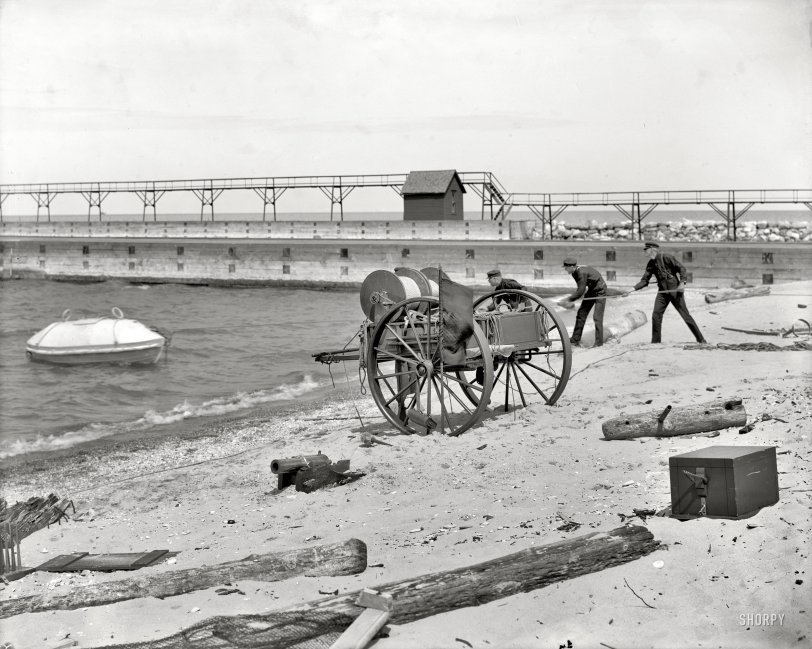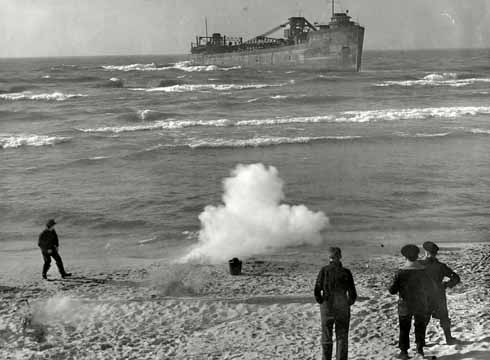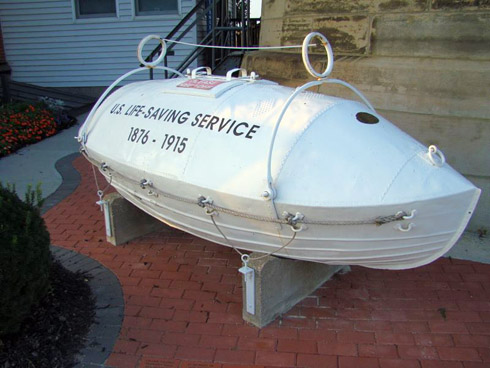


Framed or unframed, desk size to sofa size, printed by us in Arizona and Alabama since 2007. Explore now.
Shorpy is funded by you. Patreon contributors get an ad-free experience.
Learn more.

- Lost in Toyland
- And without gloves
- If I were a blindfolded time traveler
- Smoke Consumer Also Cooks
- Oh that stove!
- Possibly still there?
- What?!?
- $100 Reward
- Freeze Frame
- Texas Flyer wanted
- Just a Year Too Soon
- WWII -- Replacing men with women at the railroad crossing.
- Yes, Icing
- You kids drive me nuts!
- NOT An Easy Job
- I wonder
- Just add window boxes
- Icing Platform?
- Indiana Harbor Belt abides
- Freezing haze
- Corrections (for those who care)
- C&NW at Nelson
- Fallen Flags
- A dangerous job made worse
- Water Stop
- Passenger trains have right of way over freights?
- Coal
- Never ceases to amaze me.
- Still chuggin' (in model form)
- Great shot
Print Emporium
Life Savers: 1908

Charlevoix, Michigan, circa 1908. "Life saving crew practice." 8x10 inch dry plate glass negative, Detroit Publishing Company. View full size.
Crotch Pole?
Um, no thanks. I think I'll swim to shore.
Life Car
The small covered "boat" is a life car intended to haul up to 4 or victims ashore at a time from a wreck. The only instance of it's use on the lakes was the Hartzell wreck off Frankfort, MI. The greater use on on the Atlantic coast where wrecks sometimes had hundreds of victims aboard. Regardless of actual use frequency LSS regulations required weekly drill in its use. The shotline was used to haul a once inch whip line out (block fast to wreck and two running ends ashore) which in turn hauled a two inch hawser to the wreck where it was made fast and became actual over head rope for the breaches buoy or life car, the whip becoming the method of hauling the breaches buoy etc, back and forth. It was a far safer method of rescue when conditions permitted, namely if the wreck was within 400 yards or so of shore. If not it was into the surfboat or big lifeboat and the life-savers earned their motto - "regulations say we have to go out; they say nothing about coming back." In 1915 the LSS and Revenue Marine consolidated into the new Coast Guard.
Breeches Buoy Rescue
How it's done, explained in great detail.
Love this site! Can't get enough!!
Throw him a line!
Here's an example of the Lyle Gun at work: "The firing of Lyle Gun to the freighter J.R. Sensibar grounded in Lake Michigan December 1939 by the surf men of the U.S. Coast Guard, The projectiles with line attached is fired over the stricken vessel, so it is possible to effect a rescue without putting a rescue craft in the water and needlessly risking the lives of the rescuers."

Surf Rescue Boat
There is an identical surf rescue boat on display in front of the Fairport Harbor Lighthouse Museum (Ohio), along with a slightly different Lyle gun. The boat is built like a mini submarine, much safer than a breeches buoy. It was run out along the rescue line to the ship in distress. The Lyle gun fired a light line, that was used to haul out the main rescue line.
The lighthouse is a beauty, and the museum is jam packed with artifacts, pictures, and models, and you can go up the spiral staircase to the top of the lighthouse.
My recollection is that Brennan's Fish House over on the Grand River side has a Lyle gun like this one, along with a museum quality collection of marine artifacts collected by the owner. (Great food too).

"Life Car"
The cigar-like object bobbing offshore is a "life car" which was used as an alternative method for removing victims from a stranded ship. It could make repeated trips between ship and shore, carrying multiple passengers in its watertight interior.
According to one source, the car held enough air for eleven (!) passengers for three minutes, although in practice it appears four to six people was the more common load.
Clumsy and hard to handle, life cars eventually fell out of favor while the breeches buoy served on.
Lifeline
That's exactly what the small cannon is for, shooting a line out to the victim. It was also used to place a line on board a ship that had run aground, which was more common a century ago than one might expect today. Once the light line was secured a heavier line could be pulled aboard and a breeches buoy used to evacuate the crew. These life savers are the fore runner of the current Coast Guard.
The cannon was used to start a lifeline
The lifesaving crew would fire a small bolt trailing a cable, using the grounded vessel's rigging as a target. With help from the vessel's crew, they'd bring tackle across and set up a bosun's chair to shore.
At least one lifesaving station that used this technique, Chicamacomico in North Carolina, still gives regular demonstrations. Unfortunately they're out of action until further notice in the wake of Irene, but I hope they'll recover. The demo is always a highlight of my Outer Banks vacations.
Thrown Lines
The cannon was indeed for getting the line out to a stranded boat. There's a photo of the same equipment here.
The cannon
You have it right, and I was actually able to correctly remember the name of the thing from a distant childhood memory is "Lyle gun." It was used for line throwing to enable the rigging of rescue lines and such. Google it thus and you will find plenty of information and images of the style shown and one mounted on a Civil-War looking carriage.
Cannon before radios?
Perhaps the cannon was used as a signal to alert others that a rescue was happening. A sonic SOS asking for help.
Line cannon
It looks like a line cannon. They were used on ships to cast lines to one another. I suppose it would work for casting lines to drowning victims as well.
Rescue Cannon
I believe it was to shoot a thin line out to a stranded ship, in order to rig a "breeches bouy" rescue (a large rope with a sling that looks like underwear or "breeches" hanging from it). Because of the lake's shallow beaches, a ship might ground a hundred yards offshore. On the right edge of the photo is the remains of a ship's ribs, washed up on the beach.
Lifesaving Service
In 1915, a little after this photo's time frame, the US Lifesaving Service was merged with the Revenue Cutter Service to form the US Coast Guard. In 1939, the Lighthouse Service was merged in as well.
To answer Cracker's question: The cannon was used to fire a light line, called a messenger, out to a grounded or sinking ship. It was probably designed to aim high so that the weighted projectile went over the ship, draping the messenger across it in a position to be caught, without endangering the survivors. Therefore it needed a substantial range.
This messenger line was used to haul out a heavier hawser that the ship's crew could tie to something on board. It could then be used as a jackline to run a breeches buoy out to the ship to bring off the crew one by one. In this photo, however, it seems that instead of a breeches buoy, which is a sort of sling you sit in that runs along the hawser on a pulley, they are practicing with a tethered mini-lifeboat. The hawser might run through the two metal rings on top of the boat to keep it on course. The men at the right of the photo are pulling in the boat using one of the control lines; the other would go out to the disabled ship to bring the boat back for repeated runs.
A breeches buoy could only rescue one person at a time. It might be that two could fit in this tethered boat, but probably not. The rescue process would therefore go on for a substantial time and depended entirely on the ship holding together long enough for the entire crew to escape one at a time. In the big waves that could be expected in storms, it might be that survivors needed to batten themselves into the rescue boat to avoid either drowning themselves or sinking it. That's why it has a hatch, closed in the photo.
Lyle Gun
That small cannon is called a Lyle Gun - after its inventor - David A. Lyle.
These line guns are used primarily for shore based rescue operations. The Lyle Gun was hauled to the shoreline usually by U.S.L.L.S. surfmen in specially made beach carts. The Surfmen would set up and fire the Lyle gun, aiming over the stranded or wreaked vessel and then pull the line within reach of the victims. Once the breeches buoy lines and the Crotch Pole(an A frame) assembled, the survivors could be removed from the vessel by hand hauling the breeches buoy lines.
Baby Boomer
I wonder what that small cannon was for. I remember in Tom Sawyer (I think) that Mark Twain explained how cannon were fired either across the river or from steamboats in order to make corpses rise to the surface. Surely this little pop gun wasn't used for that. Perhaps it was used like a harpoon gun to throw line out to drowning victims? That doesn't sound all that feasible either. I'm grasping at straws here.
























On Shorpy:
Today’s Top 5